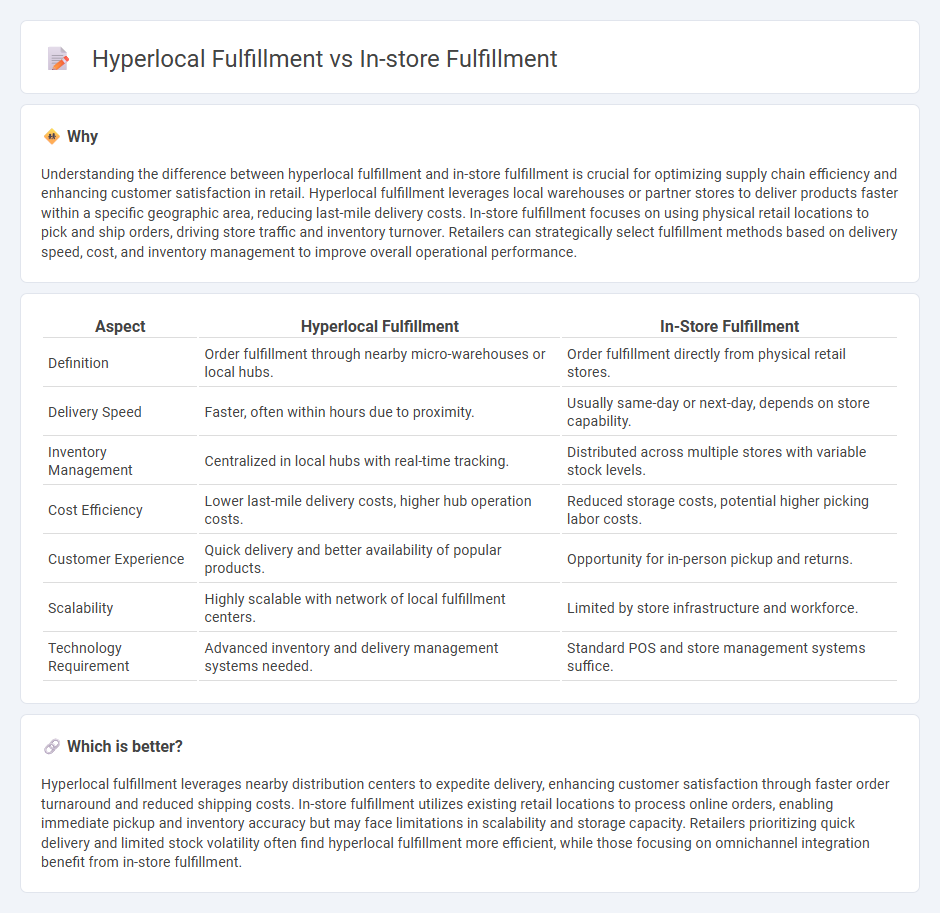
Hyperlocal fulfillment leverages local distribution centers or micro-fulfillment hubs to deliver products swiftly within a limited geographic area, enhancing delivery speed and reducing logistics costs. In-store fulfillment relies on physical retail locations to pick and ship online orders, balancing inventory visibility with customer convenience and instant pickups. Explore the advantages and challenges of both strategies to optimize your retail supply chain.
Why it is important
Understanding the difference between hyperlocal fulfillment and in-store fulfillment is crucial for optimizing supply chain efficiency and enhancing customer satisfaction in retail. Hyperlocal fulfillment leverages local warehouses or partner stores to deliver products faster within a specific geographic area, reducing last-mile delivery costs. In-store fulfillment focuses on using physical retail locations to pick and ship orders, driving store traffic and inventory turnover. Retailers can strategically select fulfillment methods based on delivery speed, cost, and inventory management to improve overall operational performance.
Comparison Table
| Aspect | Hyperlocal Fulfillment | In-Store Fulfillment |
|---|---|---|
| Definition | Order fulfillment through nearby micro-warehouses or local hubs. | Order fulfillment directly from physical retail stores. |
| Delivery Speed | Faster, often within hours due to proximity. | Usually same-day or next-day, depends on store capability. |
| Inventory Management | Centralized in local hubs with real-time tracking. | Distributed across multiple stores with variable stock levels. |
| Cost Efficiency | Lower last-mile delivery costs, higher hub operation costs. | Reduced storage costs, potential higher picking labor costs. |
| Customer Experience | Quick delivery and better availability of popular products. | Opportunity for in-person pickup and returns. |
| Scalability | Highly scalable with network of local fulfillment centers. | Limited by store infrastructure and workforce. |
| Technology Requirement | Advanced inventory and delivery management systems needed. | Standard POS and store management systems suffice. |
Which is better?
Hyperlocal fulfillment leverages nearby distribution centers to expedite delivery, enhancing customer satisfaction through faster order turnaround and reduced shipping costs. In-store fulfillment utilizes existing retail locations to process online orders, enabling immediate pickup and inventory accuracy but may face limitations in scalability and storage capacity. Retailers prioritizing quick delivery and limited stock volatility often find hyperlocal fulfillment more efficient, while those focusing on omnichannel integration benefit from in-store fulfillment.
Connection
Hyperlocal fulfillment leverages in-store inventory to quickly deliver products within a localized area, reducing delivery times and costs. Retailers integrate their physical stores as micro-distribution centers, enabling efficient order picking and same-day delivery. This connection enhances customer satisfaction by combining the convenience of e-commerce with the immediacy of brick-and-mortar presence.
Key Terms
Inventory Management
In-store fulfillment leverages existing retail inventory to quickly process and ship customer orders directly from physical store locations, reducing delivery times and utilizing current stock levels efficiently. Hyperlocal fulfillment optimizes inventory distribution by utilizing nearby micro-warehouses or dark stores, focusing on ultra-fast delivery within a constrained geographic area through real-time inventory tracking. Explore the advantages and strategies behind these models to enhance your inventory management system.
Order Pick-up Location
In-store fulfillment utilizes the physical retail store as the pick-up location, enabling customers to collect orders directly from a nearby branch, which enhances convenience and reduces last-mile delivery costs. Hyperlocal fulfillment, however, often involves local micro-warehouses or dark stores strategically positioned in close proximity to customers to speed up delivery times, with pick-up points that may include lockers or local shops. Explore more about these fulfillment strategies to optimize your supply chain and improve customer satisfaction.
Delivery Radius
In-store fulfillment typically operates within a limited delivery radius, leveraging physical retail locations to quickly process and dispatch orders nearby. Hyperlocal fulfillment expands this radius by utilizing distributed micro-warehouses or local partner networks, enabling faster deliveries across a broader area while maintaining efficiency. Explore the nuances of delivery radius optimization to enhance your fulfillment strategy.
Source and External Links
What is In Store Fulfillment & Why Is It Important For You? - Hopstack - In-store fulfillment is an omnichannel strategy where physical stores fulfill customer orders locally instead of warehouses, enabling faster and more cost-effective shipping by leveraging store proximity to consumers.
The Power of In-Store Fulfillment: Why it's Time to Gain ... - Total Retail - In-store fulfillment helps retailers reduce delivery times and shipping costs by using inventory already in local stores, meeting increasing consumer demands for fast shipping and flexible delivery options.
Store fulfillment: Importance and 4 principles to utilize it in retail - Store fulfillment transforms brick-and-mortar stores into micro-fulfillment centers, enabling flexible options like buy online pick up in store (BOPIS) and ship-from-store, improving cost efficiency, customer satisfaction, and order speed.
 dowidth.com
dowidth.com